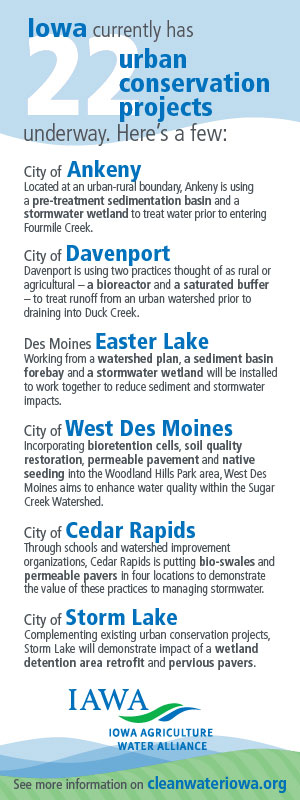 Demand for Conservation Practices from Producers
Demand for Conservation Practices from Producers
Jonathan Gano is the public works director for the city of Des Moines. He also may be helping a few farmers build bioreactors to remove nitrates leaving their fields.
“Two of the key raw materials involved in bioreactors are wood chips and a hole in the ground,” he says. “Through the storm water utility and its maintenance staff we have the ability to create holes in the ground and through management of the urban forest and our 38,000 trees in city spaces and parklands we have a bottomless supply of wood chips to fill the ground with.”
Gano recently talked about urban-rural water quality partnerships at the recent Iowa Water Conference held at Iowa State University. He did so during a panel discussion moderated by the Iowa Agriculture Water Alliance (IAWA).
Within the 90 square miles of the city, there are “thousands of acres of farmland,” according to Gano.
Vision of Cleaner Water Beyond City Limits
But Gano’s vision of cleaner water extends far beyond the city limits. Rather, it looks upstream to the watersheds feeding the Des Moines and Raccoon Rivers. Gano’s department manages both storm water and sewer lines within the city as well as maintaining flood control levees. (In Des Moines, drinking water is treated by a separate entity, the Des Moines Water Works. Gano has nothing to do with the lawsuit filed against drainage districts in three northern Iowa counties over nitrates in the Raccoon River.)
Des Moines has its own water issues. In 2010 the city and the regional Wastewater Reclamation Authority, that the city manages in conjunction with 16 other municipal governments, signed a consent agreement with state and federal regulators to separate antiquated sanitary sewer and storm sewer discharges, a $205-million project through 2023. Des Moines is one of more than 100 cities in Iowa that have agreed to a statewide nutrient reduction strategy. This agreement calls for reducing wastewater output of phosphorus by 75 percent and nitrogen by 66 percent. And the city is trying to prevent a repeat of the flooding disaster of 1993. They hope to prevent this partly with more and higher levees.
Taxpayers may not be willing to spend large amounts on higher levees forever, Gano believes.
Increase Resiliency Where the Rivers Come Together
“We’ll need to look at keeping water where it lands for longer times to take the peaks down and increase the resiliency of our city where the rivers come together,” he says. “We’re sticking to the idea that the next generation of flood control for the city of Des Moines will be out in the landscapes. That means we will be working outside our jurisdictional boundaries.”
Iowa cities have flexibility to work outside of their borders. This is due to “the understanding that water quality and flood mitigation are two sides to the same coin,” he says.
A $97 million grant from the federal Department of Housing and Urban Development was announced in January. It will help Iowa cities be better prepared against flooding. It includes approximately $31 million that can be invested in conservation practices on farms, says Sean McMahon. McMahon is the Executive Director of IAWA.
The Midwest Agriculture Water Quality Partnership Project
The USDA also has a new program to leverage its conservation dollars with local governments and private groups. The Regional Conservation Partnership Program authorized by the 2014 Farm Bill made its largest grant this year, $9.5 million. It gave this grant to the Midwest Agriculture Water Quality Partnership (The Midwest Parntership). That partnership, co-led by IAWA and the Iowa Department of Agriculture and Land Stewardship, also will draw on $4.75 million in state funds and $33 million in funds from businesses and local governments. This is including $2.3 million from Des Moines. The Midwest Partnership will target key watersheds to help pay for practices. These practices include cover crops, nutrient management, strip-till and no-till, drainage water management, bioreactors, saturated buffers and wetlands.
Cities in Iowa want to try to achieve reductions in nitrogen (N) and phosphorus (P) output from wastewater treatment systems at a reduced cost. As a result, this can include working with farmers in their watershed to cost-share for practices. These practices may reduce N and P more efficiently instead of merely implementing technology at the plant, says Dustin Miller. Miller is a general counsel for the Iowa League of Cities. He also spoke at the Iowa Water Conference.
“The other thing that we have going for us in Iowa, is the demand for conservation practices from producers. You don’t see this in other states,” Miller says.
